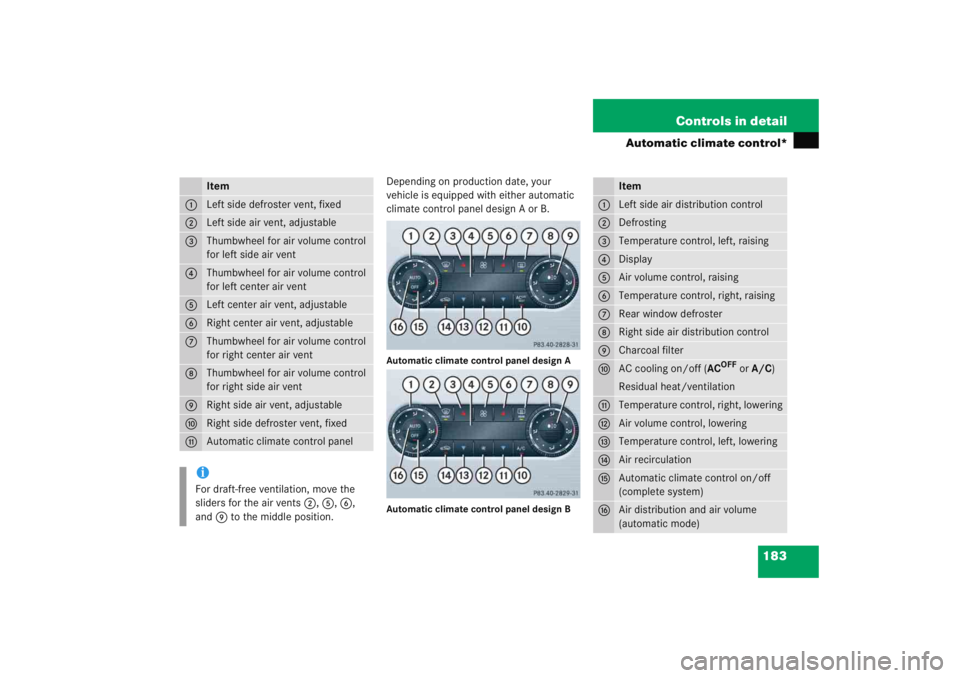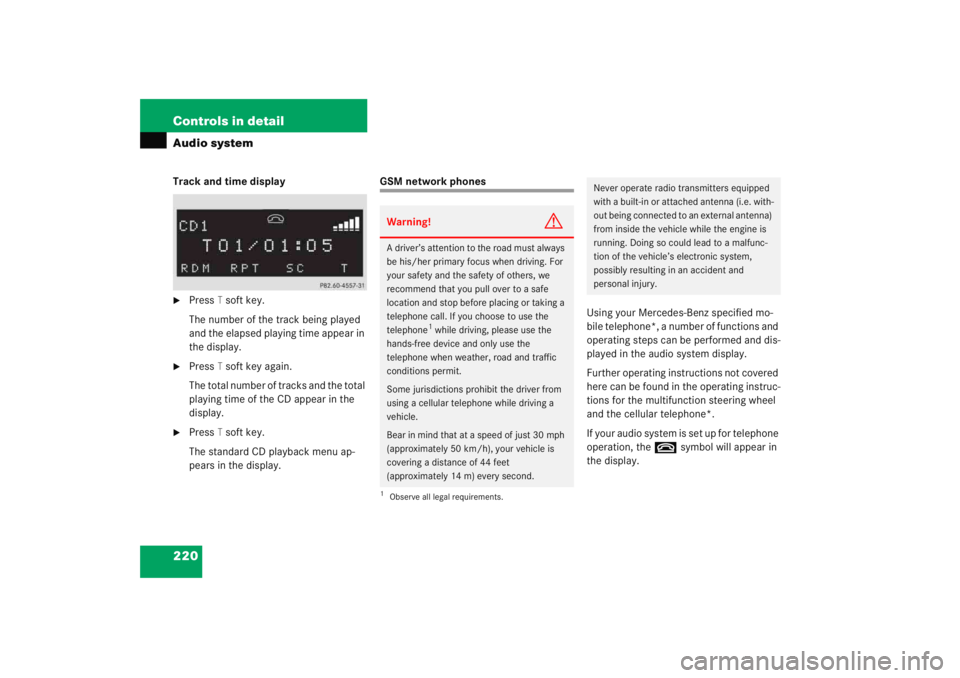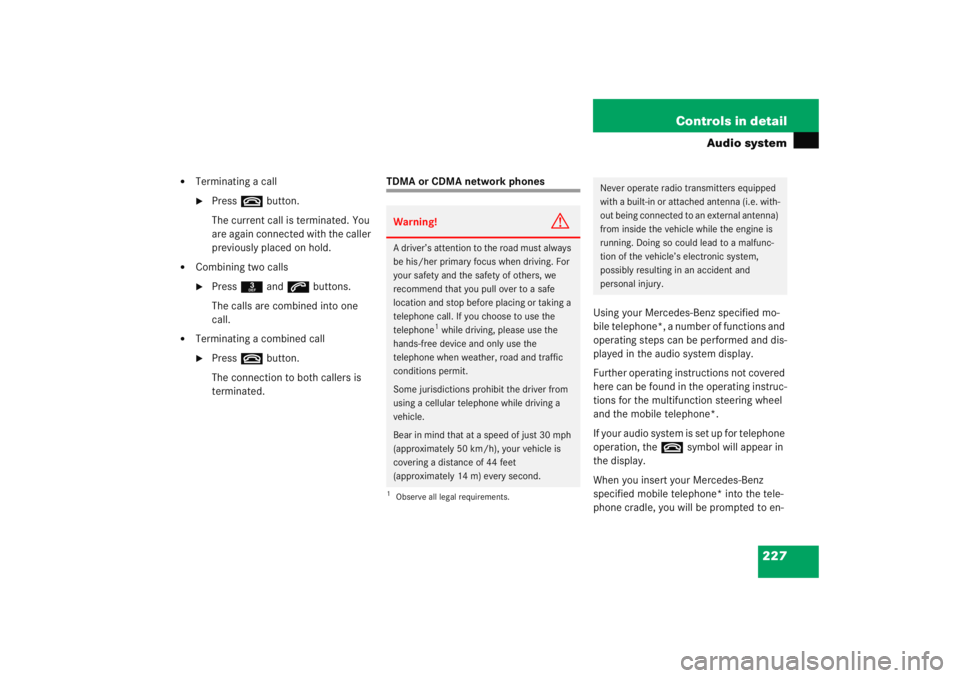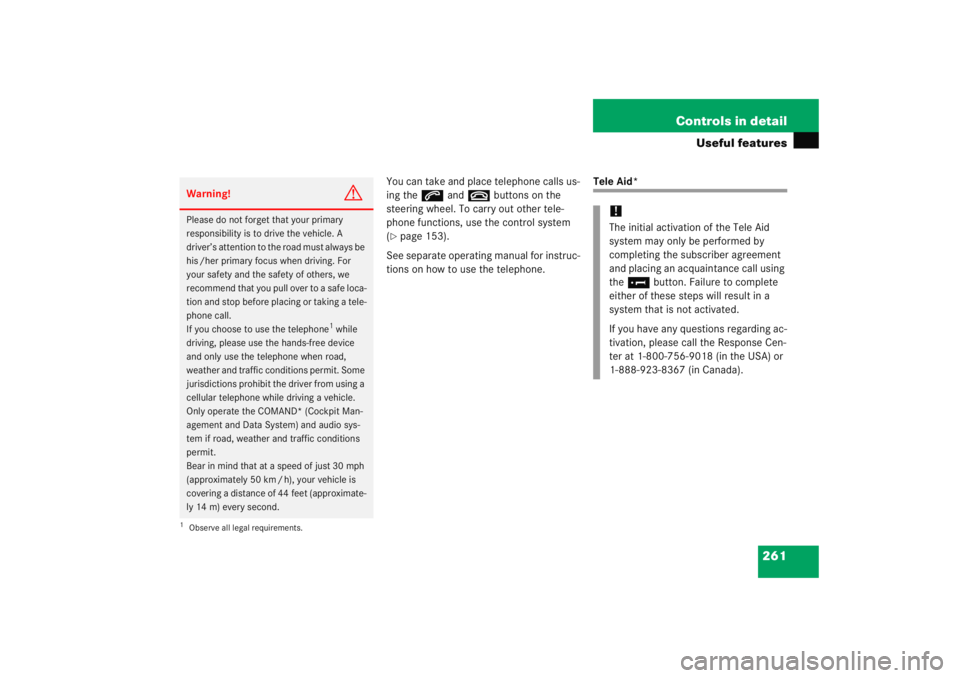Page 181 of 474
180 Controls in detailClimate control
Rear passenger compartment adjustable air vents
The air conditioning for the rear passenger
compartment is controlled via the climate
control panel (
�page 173).The air vents for the rear passenger
compartment are located in the rear
center console.
1 Left center air vent
2 Thumbwheel for air volume control for
center air vents
3 Right center air vent
!If the air conditioning cannot be turned
on again, this indicates that the air
conditioning is losing refrigerant. The
compressor has turned itself off.
Have the air conditioning checked at
the nearest authorized Mercedes-Benz
Center.
iThe temperature at the center air vents
for the rear passenger
compartment 1 and 3 is the same as
at the dashboard center air vents.
Page 182 of 474
181
Controls in detail
Climate control
Adjusting air distribution�
Push the slide for the left center
vent
1 or right center vent 3 to the
left, right, up or down.
The air flow is directed in the corre-
sponding direction. Adjusting air volume
�
Turn thumbwheel
2 up or down.
The air volume is increased or
decreased.
iFor draft-free ventilation, push
slides 1 and 3 upward.
Page 184 of 474

183
Controls in detail
Automatic climate control*
Depending on production date, your
vehicle is equipped with either automatic
climate control panel design A or B.Automatic climate control panel design A
Automatic climate control panel design B
Item
1
Left side defroster vent, fixed
2
Left side air vent, adjustable
3
Thumbwheel for air volume control
for left side air vent
4
Thumbwheel for air volume control
for left center air vent
5
Left center air
vent, adjustable
6
Right center air vent, adjustable
7
Thumbwheel for air volume control
for right center air vent
8
Thumbwheel for air volume control
for right side air vent
9
Right side air vent, adjustable
a
Right side defroster vent, fixed
b
Automatic climate control paneliFor draft-free ventilation, move the
sliders for the air vents 2,5 ,6 ,
and 9 to the middle position.
Item
1
Left side air distribution control
2
Defrosting
3
Temperature control, left, raising
4
Display
5
Air volume control, raising
6
Temperature control, right, raising
7
Rear window defroster
8
Right side air distribution control
9
Charcoal filter
a
AC cooling on/off ( AC
OFF
or A/C )
Residual heat/ventilation
b
Temperature control, right, lowering
c
Air volume control, lowering
d
Temperature control, left, lowering
e
Air recirculation
f
Automatic climate control on/off
(complete system)
g
Air distribution and air volume
(automatic mode)
Page 195 of 474
194 Controls in detailAutomatic climate control*Rear passenger compartment adjustable air vents
The air conditioning for the rear passenger
compartment is controlled via the auto-
matic climate control panel (
�page 183).
The air vents for the rear passenger
compartment are located in the rear
center console. 1
Left center air vent
2 Thumbwheel for air volume control for
center air vents
3 Right center air vent Adjusting air distribution
�
Push the slide for the left center
vent
1 or right center vent 3 to the
left, right, up, or down.
The air flow is directed in the
corresponding direction.
Adjusting air volume
�
Turn thumbwheel 2 up or down.
The air volume is increased or
decreased.
iThe temperature at the center air vents
for the rear passenger
compartment 1 and 3 i s t h e s a m e a s
at the dashboard center air vents.
iFor draft-free ventilation, push
slides 1 and 3 upward.
Page 221 of 474

220 Controls in detailAudio systemTrack and time display�
Press
T soft key.
The number of the track being played
and the elapsed playing time appear in
the display.
�
Press
T soft key again.
The total number of tracks and the total
playing time of the CD appear in the
display.
�
Press
T soft key.
The standard CD playback menu ap-
pears in the display.
GSM network phones
Using your Mercedes-Benz specified mo-
bile telephone*, a number of functions and
operating steps can be performed and dis-
played in the audio system display.
Further operating instructions not covered
here can be found in the operating instruc-
tions for the multifunction steering wheel
and the cellular telephone*.
If your audio system is set up for telephone
operation, the tsymbol will appear in
the display.Warning!
G
A driver’s attention to the road must always
be his/her primary focus when driving. For
your safety and the safety of others, we
recommend that you pull over to a safe
location and stop before placing or taking a
telephone call. If you choose to use the
telephone
1 while driving, please use the
hands-free device and only use the
telephone when weather, road and traffic
conditions permit.
Some jurisdictions prohibit the driver from
using a cellular telephone while driving a
vehicle.
Bear in mind that at a speed of just 30 mph
(approximately 50 km/h), your vehicle is
covering a distance of 44 feet
(approximately 14 m) every second.
1Observe all legal requirements.
Never operate radio transmitters equipped
with a built-in or attached antenna (i.e. with-
out being connected to an external antenna)
from inside the vehicle while the engine is
running. Doing so could lead to a malfunc-
tion of the vehicle’s electronic system,
possibly resulting in an accident and
personal injury.
Page 228 of 474

227
Controls in detail
Audio system
�
Terminating a call�
Press
t button.
The current call is terminated. You
are again connected with the caller
previously placed on hold.
�
Combining two calls�
Press 3 and s buttons.
The calls are combined into one
call.
�
Terminating a combined call�
Press t button.
The connection to both callers is
terminated.
TDMA or CDMA network phones
Using your Mercedes-Benz specified mo-
bile telephone*, a number of functions and
operating steps can be performed and dis-
played in the audio system display.
Further operating instructions not covered
here can be found in the operating instruc-
tions for the multifunction steering wheel
and the mobile telephone*.
If your audio system is set up for telephone
operation, the t symbol will appear in
the display.
When you insert your Mercedes-Benz
specified mobile telephone* into the tele-
phone cradle, you will be prompted to en-Warning!
G
A driver’s attention to the road must always
be his/her primary focus when driving. For
your safety and the safety of others, we
recommend that you pull over to a safe
location and stop before placing or taking a
telephone call. If you choose to use the
telephone
1 while driving, please use the
hands-free device and only use the
telephone when weather, road and traffic
conditions permit.
Some jurisdictions prohibit the driver from
using a cellular telephone while driving a
vehicle.
Bear in mind that at a speed of just 30 mph
(approximately 50 km/h), your vehicle is
covering a distance of 44 feet
(approximately 14 m) every second.
1Observe all legal requirements.
Never operate radio transmitters equipped
with a built-in or attached antenna (i.e. with-
out being connected to an external antenna)
from inside the vehicle while the engine is
running. Doing so could lead to a malfunc-
tion of the vehicle’s electronic system,
possibly resulting in an accident and
personal injury.
Page 248 of 474

247
Controls in detail
Driving systems
� Driving systems
The driving system of your vehicle is
described on the following pages:�
Cruise control, with which the vehicle
can maintain a preset speed
For information on the BAS, ABS and ESP
driving systems, see “Driving safety sys-
tems” (
�page 81).
Cruise control
Cruise control automatically maintains the
speed you set for your vehicle.
Use of cruise control is recommended for
driving at a constant speed for extended
periods of time. You can set or resume
cruise control at any speed over 20 mph
(30 km/h).
The cruise control function is operated by
means of the cruise control lever.
The cruise control lever is the uppermost
lever on the left-hand side of the steering
column.
Warning!
G
Cruise control is a convenience system
designed to assist the driver during vehicle
operation. The driver is and must remain at
all times responsible for the vehicle speed
and for safe brake operation.
Only use cruise control if the road, the traffic
and weather conditions make it advisable to
travel at a steady speed.�
The use of cruise control can be danger-
ous on winding roads or in heavy traffic
because conditions do not allow safe
driving at a steady speed.
�
The use of cruise control can be danger-
ous on slippery roads. Rapid changes in
tire traction can result in wheel spin and
loss of control.
�
Deactivate cruise control when driving
in fog.
The “Resume” function should only be oper-
ated if the driver is fully aware of the previ-
ously set speed and wishes to resume this
particular preset speed.
Page 262 of 474

261
Controls in detail
Useful features
You can take and place telephone calls us-
ing the
s andt buttons on the
steering wheel. To carry out other tele-
phone functions, use the control system
(�page 153).
See separate operating manual for instruc-
tions on how to use the telephone.
Tele Aid*
Warning!
G
Please do not forget that your primary
responsibility is to drive the vehicle. A
driver’s attention to the road must always be
his /her primary focus when driving. For
your safety and the safety of others, we
recommend that you pull over to a safe loca-
tion and stop before placing or taking a tele-
phone call.
If you choose to use the telephone
1 while
driving, please use the hands-free device
and only use the telephone when road,
weather and traffic conditions permit. Some
jurisdictions prohibit the driver from using a
cellular telephone while driving a vehicle.
Only operate the COMAND* (Cockpit Man-
agement and Data System) and audio sys-
tem if road, weather and traffic conditions
permit.
Bear in mind that at a speed of just 30 mph
(approximately 50 km / h), your vehicle is
covering a distance of 44 feet (approximate-
ly 14 m) every second.
1Observe all legal requirements.
!The initial activation of the Tele Aid
system may only be performed by
completing the subscriber agreement
and placing an acquaintance call using
the ¡ button. Failure to complete
either of these steps will result in a
system that is not activated.
If you have any questions regarding ac-
tivation, please call the Response Cen-
ter at 1-800-756-9018 (in the USA) or
1-888-923-8367 (in Canada).